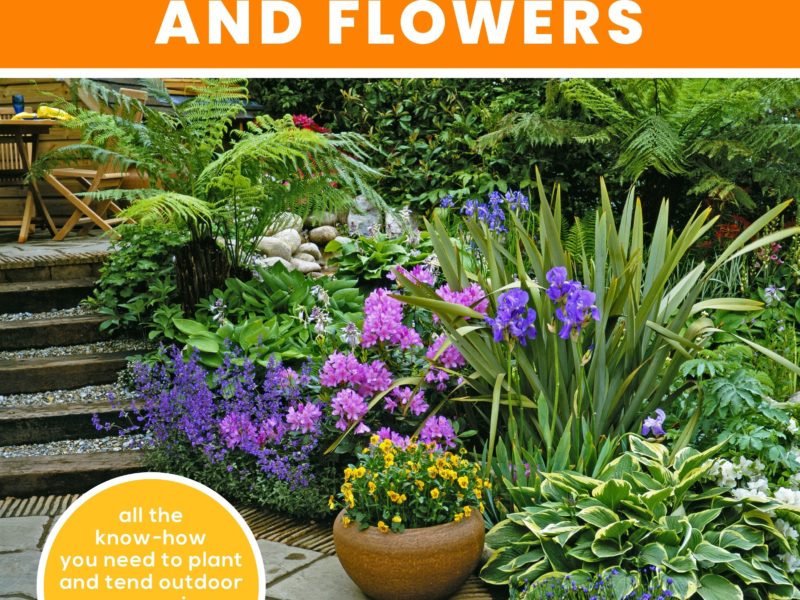

Back in the 1970s and into the 2000s, a number of very handy garden reference books came out under the Ortho imprint. These were easy-to-read, fully illustrated and fact-packed large-format paperbacks that covered a wide range of subjects like lawns, vegetable gardens, greenhouses, sprinklers, shade gardening, and a larger hardback book called the “Home Gardener’s Problem Solver.” I still use these as references, and they have a special stacking spot on one of my book cases.
Cool Springs Press seems to have filled the void left by Ortho and has just published three titles that I teased you about during the winter. These books are now out, the review copies have arrived, and it’s time to take a look. These books are slightly smaller (dimension-wise) than the Ortho series. Each of the titles is available from Amazon or from your local bookseller for about $27. And while each is intended for beginners, I think each one also makes a good reference book for your growing gardening library.
Susan Mulvihill is the long-time gardening columnist for the Spokane Spokesman-Review as well as a Master Gardener who, along with her husband, tends their five acres. Her book is “The Vegetable Garden Pest Handbook,” and while the book won’t solve all your insect problems, it sure will calm your fears and give you the basic tools for pest management and identification in the veggies.
Unlike other books on the topic, the pictures are just amazing along with important clues to help you in the process. It’s not easy, though, because insects (she refers to them as bugs, which would annoy an entomologist) go through numerous changes in their life cycles and may not look at all similar from one stage to the next, let alone from one day to the next. The book’s cover is a prime example with a picture of the Colorado potato beetle as an adult and a youngster.
The book is divided into three major sections: “Introduction to Organic Pest Management in the Vegetable Garden,” “Meet the Bugs” and lastly, “Organic Pest Management Products and DIY Controls.” But each of these major sections is further divided into topics or subjects so that by the time you’ve read from cover to cover and looked at all the pictures you can get a pretty good idea of who’s doing what to your veggies and how to deal with them. And yes, they’re on the way.
In the first section you’ll learn that insects in the garden don’t spell doom. Some of them can play havoc and some are beneficial. The discussion of IPM (Integrated Pest Management) is critical as practicing IPM seriously reduces not just the insects but the need for insecticides. There’s also an important discussion of cultural practices (keeping things clean) and the place and need for pollinators and beneficial insects in your veggie plot.
In part two, “Meet the Bugs,” Susan goes over a few critical terms (honeydew in this case is not a melon) that can help in describing what you’re seeing. And yes, like me, she’s pretty emphatic about the need for a hand lens. The section then moves on to specific veggie crops from artichokes to turnips (zucchini is under squash) but I wish she had included a section on garden herbs.
Next are the profiles of the individual insects from aphids to wireworms, and for each insect covered she reviews the insect’s life cycle, where the insect can be found as well as natural predators and control methods. Just about every insect found in our veggie gardens are in this section along with pictures of not just the insect but the damage done by it. So often we find one or the other, but here you have both, and you’ll have many an “aha” moment as you see the two side by side. If you don’t know what it is, you probably can’t control it.
The third and last major section contains the organic (and biological) methods you can use for controlling all these critters. No Sevin, no Malathion, just the organics, which are really all you need, though you will also learn that a spray of water can do magic sometimes. At the end of the book there’s a resource section as well as a “bug mugshot gallery” that includes more insect pictures and references to where the information on that insect can be found in the book.
The book is a great refresher for experienced veggie gardeners and a must for those just starting out. It’s a great investment in your garden and a tool you’ll rely on from planting to harvest. Lots of green thumbs for this one.
Tight on space but still want that apple tree, peach tree, home-grown grapes, raspberries and strawberries? Maybe more? No worry. I’ve got the perfect book to get you started and well on your way: In Christy Wilhelmi’s “Growing Your Own Mini Fruit Garden: Planting and tending small fruit trees in garden containers” you’ll learn that you really don’t need massive spaces for your fruits and berries.
Using carefully chosen plants, your balcony, terrace and small outdoor spaces can still produce the fruits you want and with abundance. But you need to read the book as a new set of gardening skills and knowledge will be necessary.
This isn’t just a book on finding the right plant for the right spot or pot. Wilhelmi covers the entire subject of growing fruits on the mini, from what to choose and how to plan to how to maintain and the often perplexing task of pruning. But she also gets into the nitty-gritty of what each fruit needs in terms of cold. Yes, some fruits need a certain period of cold to set buds and thus fruits. She goes a step beyond though, teasing us with a chapter on grafting. You’ll learn about the importance of root stocks, but you’ll also learn how, if you choose the proper root stock, you can grow several different apple varieties on one tree.
Grafting might intimidate you, but she carefully goes through the process step by step and the pictures (including the tools you’ll need) along with diagrams and drawings are all you’ll need to get started on your Macintosh, Ida Red and Macoun all growing on the same tree. The fruit is the normal size, only the tree is smaller.
One of the eight chapters is dedicated to berries and other fruits. This includes a discussion of primocanes and floricanes and if you don’t know about these you may never succeed with plants like raspberries and blackberries. Then there are the uprights and the trailers and the critical subject of how and when to prune these plants.
There’s just so much great and up-to-date information in this book that I’d even recommend it if you only want to plant a few fruits and berries in the landscape but this is really a critical primer and terrific reference for those who want a fruit and berry refresher. She makes it very clear that you can do fruits and berries on the mini and still have a grand harvest.
One quip, though: In growing plants outdoors year-round in containers there should be some consideration of the effects of soil temperatures in above-ground pots in the winter as opposed to those planted directly into soil. I’ve seen potted shrubs that do fine in the garden not overwinter in pots simply because the soil got so cold that the roots didn’t overwinter.
And one more thing about potted fruits: The author correctly notes that garden soils and regular potting soils shouldn’t be used when fruits and berries are pot and container grown. However, the artificial potting mixes we usually get, while organic, rarely have the soil microbes in them that are necessary for a great soil. For this reason, I’d suggest that your container potting mix has some compost added to it or regular doses of compost tea. And yes, she does go over compost tea.
This is another great book to learn from and to keep as a reference. Many green thumbs for this book as well, and it’s a great read. Highly recommended.
I know from many of your emails last summer that there are plenty of new gardeners out there. Some of you have never gardened before, and the pandemic gave you the opportunity. Others have dabbled previously then ran into problems that they found challenging and often frustrating.
In “The First-Time Gardener: Growing Plants and Flowers,” the husband and wife team of Allison and Sean McManus have gleaned from years of horticultural and science education backgrounds all the basics you need to have a great understanding of how and why plants grow as well as covering the basic gardening skills you need to be successful. A dash of botany, a sprig of horticulture, the basics of garden and landscape design as well as the tools of the trade, problem solving — all presented in a fashion that will soothe your learning anxiety. Basically, everything I’ve been writing about here for decades all in one concise 175-page book.
I was just so impressed that the two authors were able to get all this information into one book, and yet it seems to be the perfect primer for the beginning gardener. You won’t learn about your lawn, but you will learn about annuals, perennials and biennials. Early on you’ll learn about plant parts and the role that each of these parts plays in plant development then on to what makes these plants grow and the secrets of fertilizers. This could all be so technical and confusing, but in writing this book for newbies the terms and concepts are simple, logical and the nonsense that we often get confronted with in the garden suddenly begins to clear up and make lots of sense.
You’ll learn why we prune plants and how to prune them, how to deal with soils and amending them so they’re hospitable to the plants we want to grow instead of being part of the problem, growing plants from seed and why some plants are best grown from seed and others not, and the fundamentals of watering and weeding.
The appendix seems to have a few outdated resources, but there’s a great bonus and something that I wish more books included: a website that the authors have created where you can download additional information on what looks like hundreds of topics that they’ve put together.
Again, a great, great book for the beginning gardener. This one would make a great Mother’s Day or Father’s Day gift. And if you’re the one in need of a great gardening primer, this is it. A weekend’s worth of reading and a reference that you’ll use for years.
Writing garden books that can cover a topic for gardeners in this vast country’s 12 horticultural climate zones is a challenge indeed. But these three authors (and the publisher, I’m sure) have done incredible jobs in producing three great books that will serve gardeners well from Maine to California and most of the points in-between — the East End of Long Island certainly included. This was my biggest concern in doing these reviews so I looked carefully to make sure they were location appropriate. They are, and of course, keep growing.
 More Posts from Andrew Messinger
More Posts from Andrew Messinger